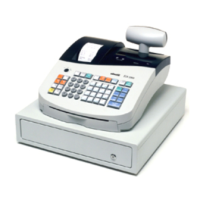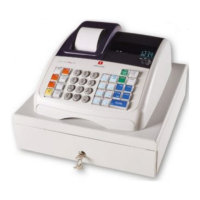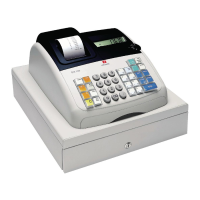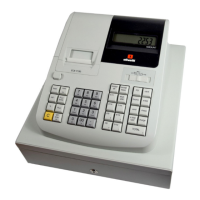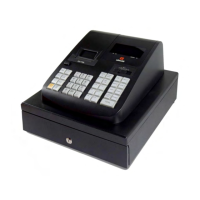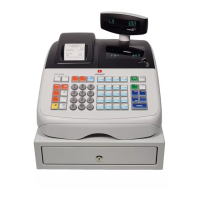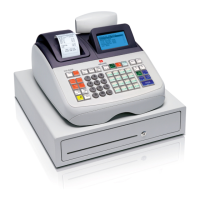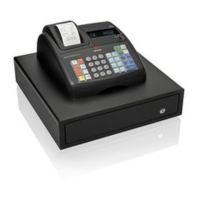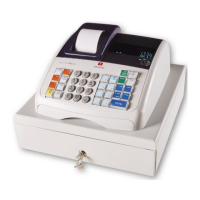2
Transaction Keypad Functions
With the transaction keypad sheet installed and with refer-
ence to figure 5:
1.
- Advances the receipt or journal paper one line
feed; advances the paper continuously when held down.
2.
- Toggles the cash register between printing and
not printing the sales receipt in the REG or MGR mode.
3. - Opens a table, calls back the items ordered at a
determined table and closes the table when the
transaction is concluded.
4.
- Confirms an entered clerk number. Used during
caption programming.
5.
- As the Guest key, enters the number of guests at
a determined table. As the Tray T-Tray key, provides the
order total of a determined guest tray in a guest party.
6.
- As the divide payment key, divides the total
amount among the guests at a table. As the Extra Invoice
key, issues an additional invoice requested by the guest
after the ordinary invoice is issued.
7. - As the New balance key, temporarily closes the
orders of a determined table until the final invoice is
issued. As the Hold/recall key, holds and then recalls a
sales transaction so that a second transaction can be
performed in the meantime.
8.
- Registers a preset price of an individual article to
the appropriate department.
9. - As the Review key, prints a proforma receipt
before finalizing the sales transaction, As the Pay Trans
key, transfers payment from one form of payment to
another after the finalization of a sales transaction.
10. - Allows price entries for departments 6-10. For
departments 11-60, press this key, then manually enter
the department number using the numeric keypad and
then press this key again.
11.
- Registers sales that are put on a credit card that
is alternative to Credit Card 1 or the one used for Charge
tenders.
12.
- Registers sales that are put on a credit card that
is alternative to Credit Card 2 or the one used for Charge
tenders.
13.
- Used to manually enter a price for a PLU article.
14. - Used to enter the first price assigned to a
determined PLU.
15.
- - Used together with [PLU page], register
the prices associated to the related PLU article.
16.
- Used to enter the second price assigned to a
determined PLU.
17. - - Direct access to PLU prices. PLU Page
1 (default) is used to select PLUs 1 to 42, PLU Page 2 to
select PLUs 201 to 242 and PLU Page 3 to select PLUs
301 to 342. You can program the PLUs associated to
these three pge keys.
18.
- Subtotals a sale, and used for the programming of
VAT rates.
19.
- Totals exact cash transactions, computes change
and totals transactions that are split tendered with check
or credit card and cash together. Prints one or more
copies of the last sales receipt.
20.
- Registers sales paid by check. Confirms the
clerk three-digit code entered.
21.
- Registers sales that are charged.
22.
- - Departments 1 through 5, to enter single
or multiple item sales to a particular department. When
pressed after
, registers to Departments 6 through 10.
23.
- Enters a decimal point for defining product
quantities with decimals during sales transactions.
24. - / - Input amounts, indicate how many
times a particular item repeats, add and subtract
percentage rates and input department code numbers.
25.
- Clears an entry made from the numeric keypad
or with before finalizing a transaction with a
Department or function key. Also used to clear error
conditions.
26.
- Deletes the last item entered, and corrects a
particular entry after it is processed and printed, or full
entries after a subtotal.
27.
- Multiplies [DEPARTMENT] or entries,
toggles between displaying the current date and the
current time. Press three times to view the number of
sales data lines still available in the Electronic Journal.
28.
- Subtracts an item that is returned for refund.
29.
- As the %2 key, when programmed accordingly
subtracts or adds a percentage from an item or sales
total. As the PO key, registers any money taken out of the
cash drawer that is not part of a sale.
30. - As the %1 key, when programmed accordingly
subtracts or adds a percentage from an item or sales
total. As the RA key, registers any money received on
account that is not part of a sale; for example, the start-
up money put in the drawer at the start of each business
day can be registered as an RA.
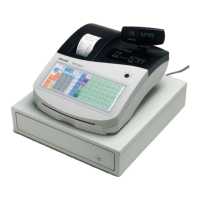
